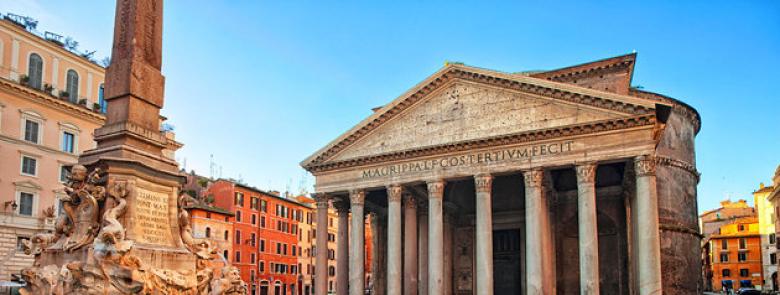Pantheon

Pantheon
A 2000-year-old temple, now church, the Pantheon is the best preserved of ancient Rome’s great monuments. In its current form it dates to around AD 120 when the emperor Hadrian built over Marcus Agrippa’s original 27 BC temple – note Agrippa's name inscribed on the pediment. The dome, considered the Romans’ greatest architectural achievement, is the largest unreinforced concrete dome ever built.
Hadrian's temple was dedicated to the classical gods – hence the name Pantheon, a derivation of the Greek words pan (all) and theos (god) – but in AD 608 it was consecrated as a Christian church. During the Renaissance it was much studied (Brunelleschi used it as inspiration for his Duomo in Florence) and became an important burial chamber. Today you'll find the tomb of the artist Raphael, alongside those of kings Vittorio Emanuele II and Umberto I.
However, the real fascination of the Pantheon lies in its massive dimensions and extraordinary dome. A tour de force of ancient engineering, it was the largest dome in the world until the 15th century and is still the largest unreinforced concrete dome in existence. Its harmonious appearance is due to a precisely calibrated symmetry – its diameter is exactly equal to the Pantheon's interior height of 43.3m. Light enters through the oculus, an 8.7m opening in the dome that also served as a symbolic connection between the temple and the gods. Rainwater enters but drains away through 22 almost-invisible holes in the sloping marble floor.
Somewhat the worse for wear, the exterior is still imposing, with 16 Corinthian columns (each a single block of stone) supporting a triangular pediment. Rivets and holes in the brickwork indicate where the original marble-veneer panels were removed.
Thanks to its consecration as a church in the 7th century, the building was spared the Christian neglect that left other structures to crumble, although it wasn't entirely safe from plundering hands. The gilded-bronze roof tiles were removed and Bernini used bronze from the portico for the baldachin at St Peter's Basilica. Thankfully, the original Roman bronze doors remain.
